Aliens Overboard - Flash Fiction
Here's a sample from my Kosmosflot universe, a flash fiction entitled:
ALIENS OVERBOARD
by Viktor Kuprin
After the battle at Attalus III was lost, we retreated with the Tsoor flotilla. Wreckage streamed off the alien ships as we made the mind-wrenching transition into S-space. I closed my eyes, praying that our cruiser wouldn’t shake itself apart.
It was only a micro-jump, just far enough to escape the attacking Helgrammites. The Tsoor group-leader didn’t believe our damaged ships could survive an extended flight. He or it or whatever was right. Three bulkheads ruptured when we re-entered normal space. I hoped no one was in them.
A bridge officer called out that we had suffered 40 percent casualties and 60 percent of our systems were red-lined. He had to shout – all intraship comm was offline.
The tech seated beside me yelled, “What are they doing? Captain!” I shouldn’t have, but I and everyone else looked away from our consoles and glanced at the main viewer.
It was one of the Tsoor ships, still surrounded by St. Elmo’s fire. Without waiting for the warp flux to dissipate, our alien allies had sent a repair team out onto their hull. They looked like four jellyfish in bubble-domed vac suits as they struggled on a safety tether. Insane! Yes, Tsoor biology is very different than ours. Even so, I knew they weren’t immune from electrocution or intense radiation. What could kill us was lethal to them, too.
“They’re desperate to send a damage-control team out like that,” said the captain. He nodded toward the chief-of-the-ship. “Send a runner to engineering. We’ve … ” The Tsoor ship lurched off the screen when an entire section of its hull exploded. We watched in silence as the four aliens were thrown into space. They flashed past our ship, tumbling and spinning on the now-useless tether.
The captain stood and shouted, “Man overboard protocol! Full retros!” He turned to face me. “Can we launch a cutter?”
The launch tubes were clear and operational. “Yes, sir.”
“Take Kuzmenko with you. Go!”
Our inertia was great, and the cutter’s engines burned at full thrust for over an hour before we actually started moving toward the alien cast-offs. No one knew how much atmosphere their vac suits carried.
Kuzmenko and I stood in the open hatch, and shot a line toward the drifting aliens. A tentacle-like arm caught it, and gave a yank.
The alien farthest away raised one of its tentacles. It held some kind of metallic tool, a small blade. With a single motion, it slashed the line and pushed off from its three companions.
“What in bloody hell is it doing?” I cried. The first Tsoor grasped its way into the airlock. I pulled them inside.
Kuzmenko pointed toward the drifting alien. “That one wants to die. Now that won’t do.” He keyed his suit’s propulsion and launched himself into space. The alien struggled briefly, but Kuzmenko was stronger.
We never learned exactly why that Tsoor went suicidal. Warrior’s honor, shock, or grief … who knows? There was no translator or dictionary onboard the cutter. The four aliens couldn’t tell us.
Nonetheless, by the end of the day, every Tsoor in the flotilla knew and honored the name Kuzmenko.
Technorati tags: science fiction, sci-fi, sf, films, movies, writing
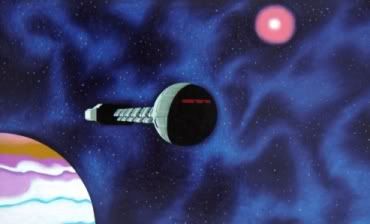 The Commonwealth of Independent Stars, the CIS, maintains a huge starship navy. It’s based on an extension of army-air force traditions, unlike the too-many-to-count wet navy versions so popular today. I don’t know about you, but I’ve grown weary of so many modern space operas reading like Horatio Hornblower or Mutiny on the Bounty. I, too, enjoy a good sea-faring yarn, but not all over the entire universe, please.
The Commonwealth of Independent Stars, the CIS, maintains a huge starship navy. It’s based on an extension of army-air force traditions, unlike the too-many-to-count wet navy versions so popular today. I don’t know about you, but I’ve grown weary of so many modern space operas reading like Horatio Hornblower or Mutiny on the Bounty. I, too, enjoy a good sea-faring yarn, but not all over the entire universe, please.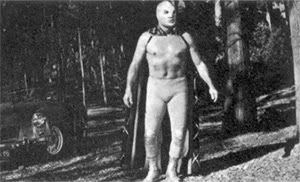 Known as “El Santo” in Mexico, this silver-masked superhero was also a championship wrestler, drove a hot little sports car, and was always battling supernatural fiends. And like so many dubbed films, they were often unintentionally hilarious. My favorite, Samson vs. The Vampire Women, is a perfect example.
Known as “El Santo” in Mexico, this silver-masked superhero was also a championship wrestler, drove a hot little sports car, and was always battling supernatural fiends. And like so many dubbed films, they were often unintentionally hilarious. My favorite, Samson vs. The Vampire Women, is a perfect example.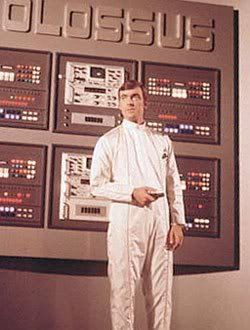 In the 1970 film COLOSSUS, THE FORBIN PROJECT, and in the original novel by D.F. Jones, the United States builds a supercomputer to control all its nuclear missiles. All the Western world’s strategic weapons are turned over to this system, called Colossus. Its first message after coming online is, “Warning: There is another system.” It’s soon confirmed that the Soviet Union is about to boot up its own super-cyber defense computer named Guardian. The story develops as Colossus and Guardian link up in their own ad hoc point-to-point network, and begin sharing data and computing capacity. America’s chief computer designer, Charles Forbin, soon regrets that he built Colossus without an off switch.
In the 1970 film COLOSSUS, THE FORBIN PROJECT, and in the original novel by D.F. Jones, the United States builds a supercomputer to control all its nuclear missiles. All the Western world’s strategic weapons are turned over to this system, called Colossus. Its first message after coming online is, “Warning: There is another system.” It’s soon confirmed that the Soviet Union is about to boot up its own super-cyber defense computer named Guardian. The story develops as Colossus and Guardian link up in their own ad hoc point-to-point network, and begin sharing data and computing capacity. America’s chief computer designer, Charles Forbin, soon regrets that he built Colossus without an off switch. The first reader to correctly answer this blog’s quiz will win a copy of THE INVADERS by Keith Laumer, the paperback novel based on the 1967 TV series, one of the Captain’s favorite SF television programs. Please post your answers in the comment section.
The first reader to correctly answer this blog’s quiz will win a copy of THE INVADERS by Keith Laumer, the paperback novel based on the 1967 TV series, one of the Captain’s favorite SF television programs. Please post your answers in the comment section.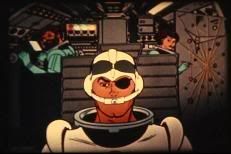 One of the earliest SF animated series that had an impact on me was Cambria Studios’ SPACE ANGEL. It appeared on Indiana’s WTTV Channel 4 early evening children’s programming in 1962. Cambria’s first series, CLUTCH CARGO, is more widely remembered. You know, “the cartoon where the only thing that moved was the lips.” Clutch never really drew my interest, but when I saw and heard the first scenes from SPACE ANGEL, I was hooked.
One of the earliest SF animated series that had an impact on me was Cambria Studios’ SPACE ANGEL. It appeared on Indiana’s WTTV Channel 4 early evening children’s programming in 1962. Cambria’s first series, CLUTCH CARGO, is more widely remembered. You know, “the cartoon where the only thing that moved was the lips.” Clutch never really drew my interest, but when I saw and heard the first scenes from SPACE ANGEL, I was hooked. SPACE ANGEL’s rocket ship, The Starduster, was truly beautiful, a classic late 50s/early 60s design, and the interior shots looked like a real cockpit in all its complexity. SPACE ANGEL (Astronaut-Lawman Scott McCloud) would snap the ship’s hand-held throttle forward, and, more often than not, an intriguing space adventure would begin.
SPACE ANGEL’s rocket ship, The Starduster, was truly beautiful, a classic late 50s/early 60s design, and the interior shots looked like a real cockpit in all its complexity. SPACE ANGEL (Astronaut-Lawman Scott McCloud) would snap the ship’s hand-held throttle forward, and, more often than not, an intriguing space adventure would begin.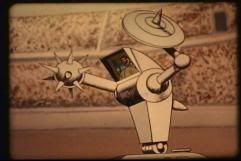 The other most memorable SPACE ANGEL episode was when Taurus is taken prisoner on a world that mimics ancient Roman society, and is forced to pilot a giant gladiator robot in an arena. Giant robots weren’t common in 1962 like they are now, and it was great fun to watch the robo combat.
The other most memorable SPACE ANGEL episode was when Taurus is taken prisoner on a world that mimics ancient Roman society, and is forced to pilot a giant gladiator robot in an arena. Giant robots weren’t common in 1962 like they are now, and it was great fun to watch the robo combat.




